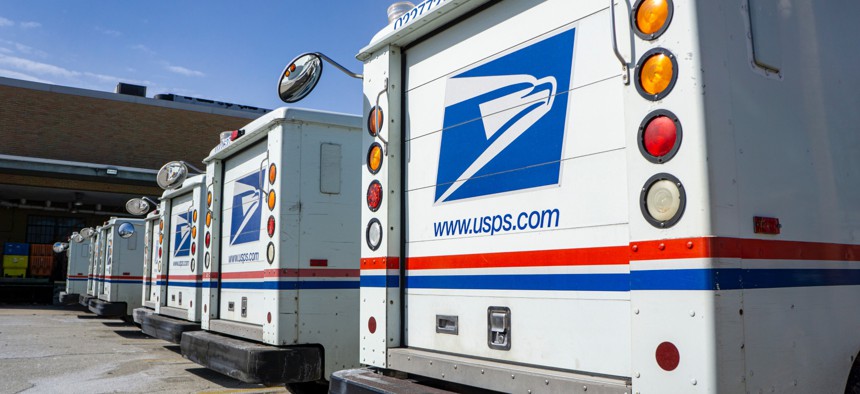USPS is getting better at hiring, but half of non-career postings still have no applicants
Postal management rejects inspector general findings and says it has encountered few workforce challenges.
The U.S. Postal Service is improving its hiring practices and onboarding employees more quickly, according to a new report, but is still struggling to recruit applicants for large swaths of positions across the country.
USPS added 192,000 employees in fiscal 2022, 184,000 in fiscal 2023 and 93,000 so far this fiscal year, but has still failed to solicit a single application for hundreds of thousands of positions over that period.
The issue is particularly acute in the “pre-career” workforce, or employees who generally only work part time and do not receive the same suite of benefits as career workers. The mailing agency had 700,000 pre-career job openings between fiscal years 2021 and 2023, the USPS inspector general found in its new report, but no prospective employees applied for more than half of them.
Two-thirds of those positions were rural carrier associates. While the IG credited postal management with taking steps that significantly improved the agency’s hiring processes, the number of postings without applicants increased to 58% in fiscal 2023. In the Wisconsin and Minnesota-North Dakota districts, 87% and 84% of RCA postings, respectively, received no applicants. Those areas also had the highest no-applicant rates for city carrier assistants.
Postmaster General Louis DeJoy launched an initiative to reduce the time it takes USPS to hire as part of his 10-year Delivering for America plan and has led an effort to convert more than 150,000 pre-career employees into career roles. Management had taken steps to hasten the hiring process in 2019, just before DeJoy’s arrival.
The Postal Service centralized its pre-career hiring process and no longer conducts interviews for those roles, instead requiring applicants to take a Virtual Entry Assessment. Those tests include videos that explain both the perks and challenges of the job. Applicants who pass the exam are then in line for openings for 90 days, while those who fail cannot apply to the same position for one year.
The Postal Service’s overall “time-to-hire” dropped by 35% from fiscal 2021 to fiscal 2023, the IG found. The auditors praised USPS for launching more virtual and in-person job fairs that include on-site exams and fingerprinting. They also noted postal management has teamed up with the agency’s marketing team for help with difficult-to-fill positions and is sending more vehicles to those areas so fewer employees have to use their personal cars and trucks.
The IG identified several hurdles, however, that are still preventing the Postal Service from soliciting a sufficient number of applicants.
“Postal Service job postings did not always receive applications in certain areas due in part to, the national unemployment rate, a rising cost of living, especially housing rates and more competitive starting wages from other employers,” the watchdog said.
The Postal Service, unlike the rest of federal government, does not adjust its wages for the cost of living. In expensive areas, the IG said, employees often cannot afford to work in pre-career roles that do not guarantee hours or fixed schedules.
The watchdog suggested management create a plan to improve recruitment for unfilled jobs, but the Postal Service rejected the recommendation and—without getting into detail—said the IG was improperly influenced. It noted in addition to other improvements, it can now text applicants throughout the hiring process to provide updates. The IG maintained that issues persist despite those reforms.
“The Postal Service disagrees with the audit findings regarding recruitment and onboarding of employees,” said Simon Storey and Thomas Blum, USPS’ vice presidents for human resources and labor relations, respectively. “We maintain the perspective that OIG’s viewpoints are influenced by a limited number of external stakeholders.”
They added management has “worked tirelessly” to boost the visibility of its hiring efforts and has “encountered few challenges” outside of a few areas.
The IG also called on the Postal Service to improve its pre-career application process by creating more realistic expectations for potential candidates. The job postings are typically vague and lack details on hours, locations and physical demands of the roles. They do not spell out whether carriers would work on walking or driving routes, for example. Facility managers complained to the auditors that the listings did not contain the requirements of specific jobs.
The lack of details contributed to high turnover, the IG said, with rates growing from 56% in fiscal 2021 to 57% in fiscal 2023. One-third of pre-career hires were no longer at USPS 90 days after they were onboarded.
Storey and Blum said USPS did not agree that the agency should provide facility-specific information in its job postings, as the listings were descriptive enough for the various positions and locations to which new employees could be assigned. They agreed the agency should better ensure local managers engage in “meet and greets” on employees’ first day at work and will send out a memorandum to that effect.
The IG said postal management’s efforts will likely fall short if it does not address locality pay. Insufficient hiring, it said, would lower job satisfaction, decrease morale and boost turnover.
“Specifically for the Postal Service, these risks can translate into low employee availability, delayed mail and increased overtime for employees on the rolls,” the IG said.




